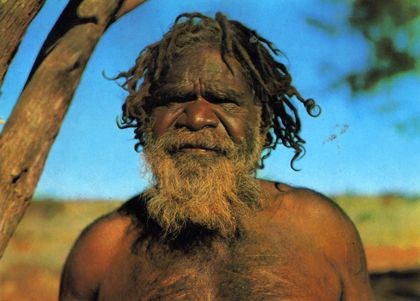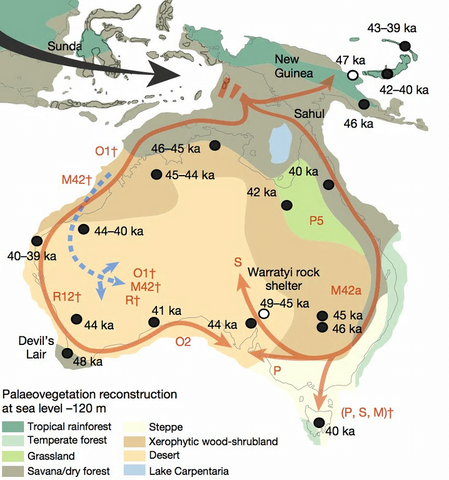How the Aborigenes came to Australia
The answers comes from 111 hair

The first humans probably reached Australia around 50,000 years ago, which is the age of the oldest human skeletons and tools found. But how did humans get there?
Answers are given by a collection of hair from Aborigines, which has been analyzed in the magazine „Nature.“ The results are surprising: all the Aborigines likely descend from a single population, which reached the Australian continent 50,000 years ago. Populations then spread rapidly – within 1,500 to 2,000 years – around the east and west coasts of Australia, meeting somewhere in South Australia. Over the following millennia, the population groups remained practically isolated.
For scientists, this is a revelation which was made possible by analyzing hair several decades old. Scientists stumble upon a problem when they want to reconstitute the Aborigenes‘ history: the fact ist hat most of them no longer live in the areas where their ancestors were dwelling. During the 20th century, many of them were forcibly displaced, in some cases, children were separated from their parents. As a result, the genetic material of the original inhabitants has become mixed up. It has become quite difficult to study the original conditions, such as would have existed before colonialism set in.
The hair of 111 Australian Aborigines, which were used for the study, were collected between 1926 and 1963. „This collection offers the best way to follow back up the pre-colonial history of the Aborigenes,“ said Alan Cooper from the University of Adelaide, a collaborator of the study. The researchers obtained approval from the descendents, to study the samples.
It was inordinately difficult to extract the genetic material because the hair are so old. A further problem: the hair were cut with scissors. The best chances to reach the genetic material of the cell nucleus occur at the hair roots. Which is why the scientists decided to settle with examining the mitochondria in the hair cells. These are the energy reactors within the cell, they contain genetic material, but only coming from the mother.
The scientists compared hair samples with those from people from other parts of the world and discovered that the Aborigenes all descend from one single population. This indicates that they reached the continent in the same migratory wave.
The DNA from the mitochondria can also be used a kind of molecular clock, as it tends to mutate relatively regularly. The scientists were able to retrocalculate that the last common ancestor of the Aborigenes which they investigated must have lived 50,000 years ago. This is concordant with the oldest archaeological finds.
The scientist surmise that Australia 50,000 years ago was part of the same landmass as New Guinea. So that the first Aborigines could have reached New Guinea by way of South East Asia and then have gone farther to Australia. There, they settled in groups over the whole continent.
Once they were settled, though, the individual groups appear to have stayed in one particular spot and to have hardly mixed with the other groups. At least the mitochondrial DNA gives no indications that they have. But not everybody is convinced of this.
Peter Bellwood, an archaeologist of Australian National University, points out that many groups of Aborigines used similar tools and shared a similar language. "If humans did not move, how could tools and languages?" he asks. Other scientists criticized that mitochondrial DNA does not suffice to yield detailed conclusions.
New information could be won from the genetic material in the cell nuclei. And that’s where Cooper and his team want to hook on with their new research. For the hair samples were found to be somewhat better preserved than had been thought earlier, and still contain the DNA from the cell nuclei. So that the researchers intend to go through the tests again, using precisely those. They have already started asking the descendents of the Aborigines for permission.
"I myself have Aborigenes ancestors. But my grandfather never spoke about this, because he had been taken away from his family. Many people in my situation have an interest in their history. This project opens up a possibility for them, „ says Ray Tobler, who also collaborated in the study.
From an article in Der Spiegel, March 9, 2017
Translated from the German by Anne-Marie de Grazia

The mitochondrial DNA study
The hair samples identified four main distinct types of maternal DNA, which they labeled “P”, “O”, “S” and “M”. Those in the O group were overwhelmingly found on the west and south coast of Australia, the researchers found. Those with the other three types mainly stuck to the east coast.
The researchers know this because the sample collectors kept detailed information about birthplaces, family history and family trees, and this – combined with film, audio and written records – allowed the researchers to create a map of movement and reconstruct history. Prof Alan Cooper said it was “amazing” that the team had found Aboriginal communities have remained in discrete geographical regions. “This is unlike people anywhere else in the world and provides compelling support for the remarkable Aboriginal cultural connection to country,” he said.
“During that period of time, with massive climate changes and massive environmental shifts, you might therefore have expected people to respond by moving all over the place.
“Clearly the environment did change significantly but nevertheless they were able to survive in one area with a fixed set of resources for up to 50,000 years. Nowhere else in world have humans been able to demonstrate an ability to do that. We don’t have a great record of living in balance with anything.”
It illustrated the enormous amount of respect, knowledge and affinity Aboriginal people must have had with the land, and to specific areas of land, to survive, It illustrated the enormous amount of respect, knowledge and affinity Aboriginal people must have had with the land, and to specific areas of land, to survive, Cooper said.
“That’s not news to Aboriginal people,” he said. “But it may help non-Aboriginal people appreciate the sheer scale and importance of that longevity. If you can try and imagine your own family history being present for 50,000 years and how important that would be to you, you can start to understand the cultural gulf apparent when Aboriginal people are talking to politicians or non-Aboriginal people about the importance of land ownership.”
Cooper believes that the absence of farming might have been the key to different groups of Aboriginal people living harmoniously for so long. No wars or conflict prompting mass movements had occurred during those early thousands of years in Australia.
“When you farm and grow large amounts of food, cheap tasty food, the population grows very rapidly and when that happens you have a huge pressure to keep supplying the food and you start building up large amounts of assets,” he said. “That produces war, where people are after those assets. Aboriginal people were able to survive [without war]. How have they managed to do that?
“Aboriginal history has some remarkably positive things to say.”
From The Guardian

